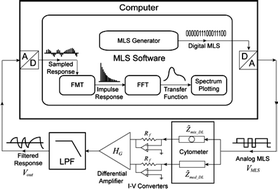High speed multi-frequency impedance analysis of single particles in a microfluidic cytometer using maximum length sequences†
Abstract
A novel impedance spectroscopy technique has been developed for high speed single biological particle analysis. A microfluidic cytometer is used to measure the impedance of single micrometre sized latex particles at high speed across a range of frequencies. The setup uses a technique based on maximum length sequence (MLS) analysis, where the time-dependent response of the system is measured in the time domain and transformed into the impulse response using fast M-sequence transform (FMT). Finally fast Fourier transform (FFT) is applied to the impulse response to give the transfer-function of the system in the frequency domain. It is demonstrated that the MLS technique can give multi-frequency (broad-band) measurement in a short time period (ms). The


 Please wait while we load your content...
Please wait while we load your content...